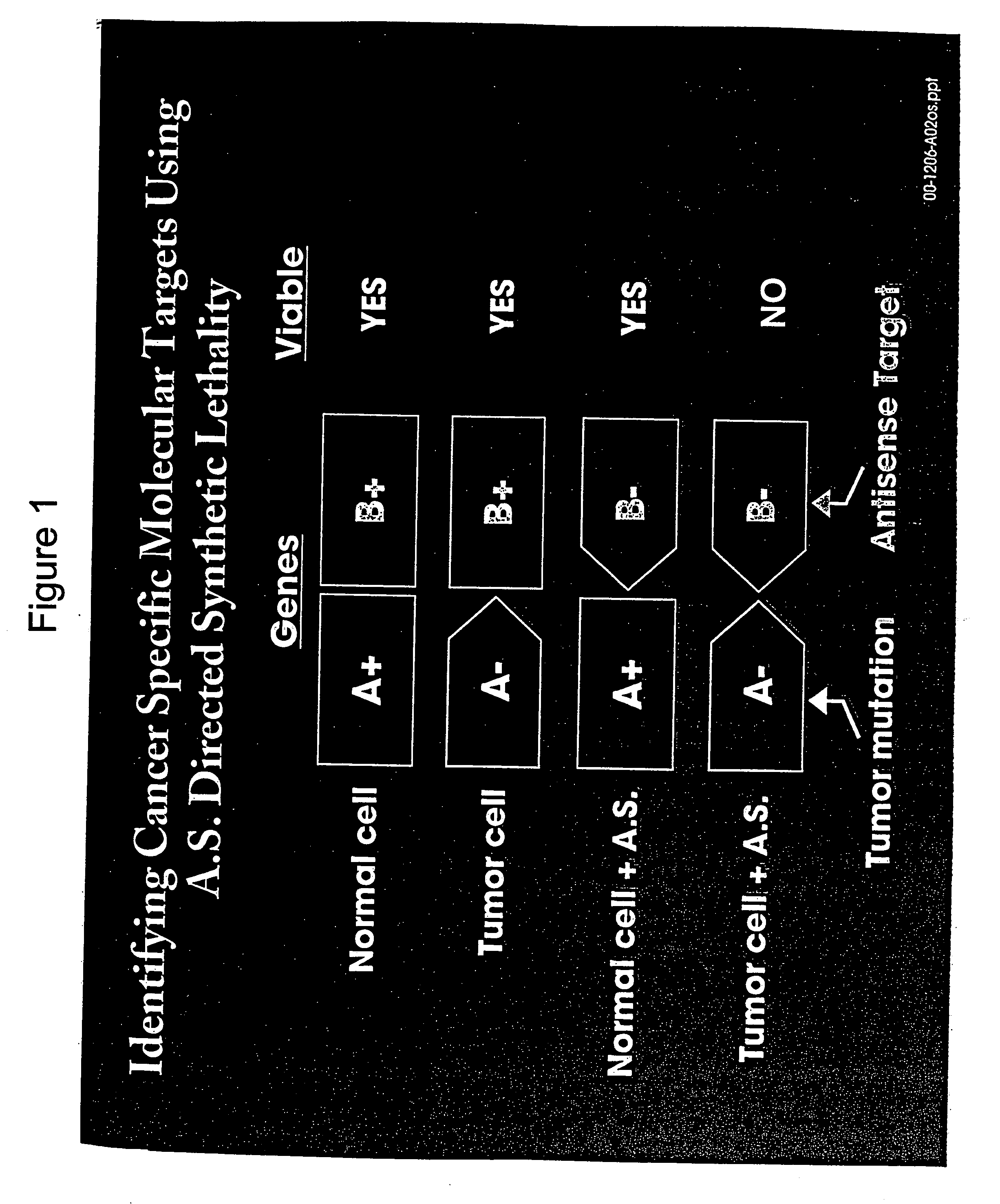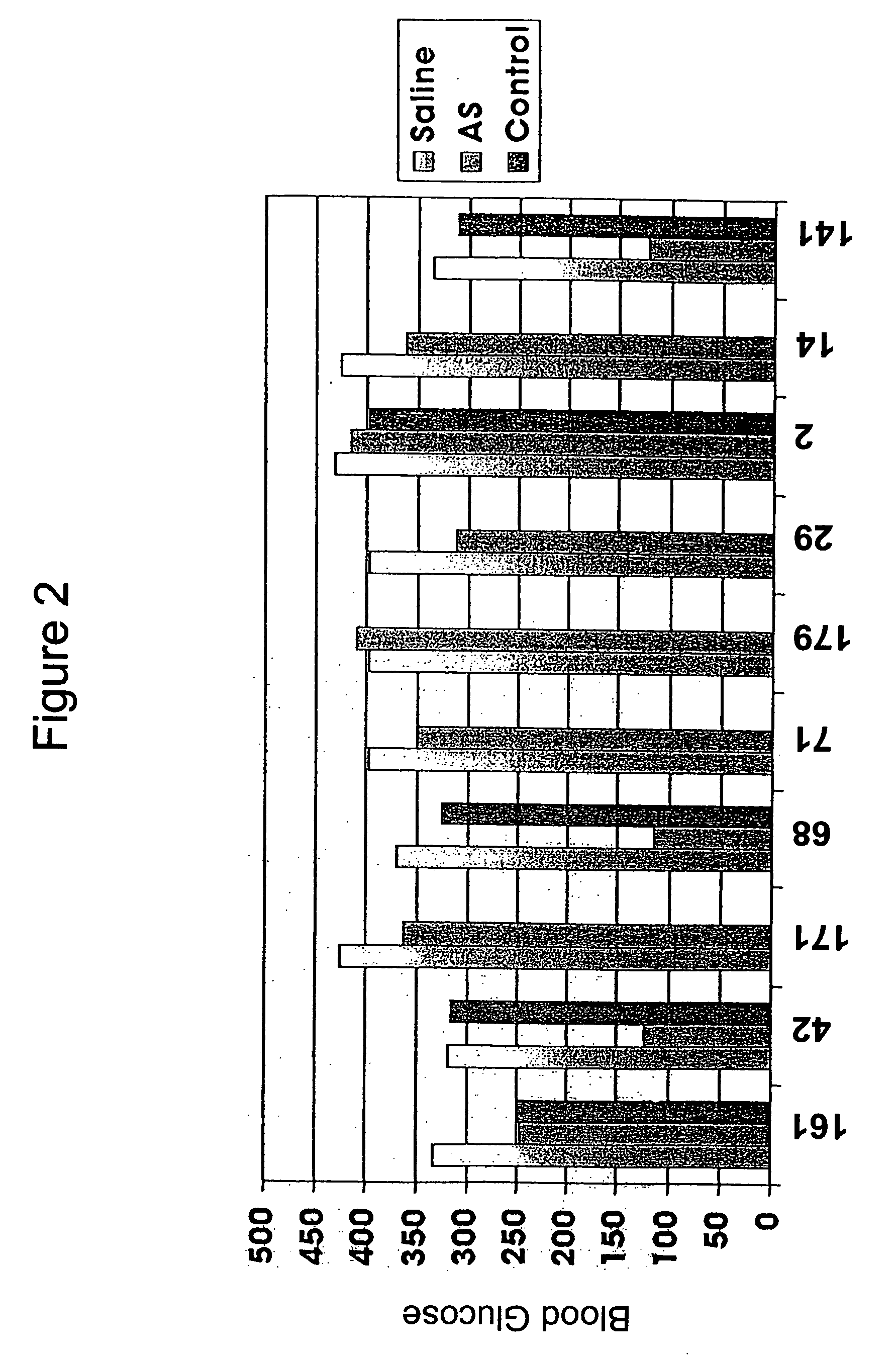Use of antisense oligonucleotide libraries for identifying gene function
- Summary
- Abstract
- Description
- Claims
- Application Information
AI Technical Summary
Benefits of technology
Problems solved by technology
Method used
Image
Examples
example 1
Nucleoside Phosphoramidites for Oligonucleotide Synthesis Deoxy and 2′-alkoxy amidites
[0166] 2′-Deoxy and 2′-methoxy beta-cyanoethyldiisopropyl phosphoramidites were purchased from commercial sources (e.g. Chemgenes, Needham MA or Glen Research, Inc. Sterling Va.) Other 2′-O-alkoxy substituted nucleoside amidites are prepared as described in U.S. Pat. No. 5,506,351, herein incorporated by reference. For oligonucleotides synthesized using 2′-alkoxy amidites, the standard cycle for unmodified oligonucleotides was utilized, except the wait step after pulse delivery of tetrazole and base was increased to 360 seconds.
[0167] Oligonucleotides containing 5-methyl-2′-deoxycytidine (5-Me-C) nucleotides were synthesized according to published methods [Sanghvi, et. al., Nucleic Acids Research, 1993, 21, 3197-3203] using commercially available phosphoramidites (Glen Research, Sterling Va. or ChemGenes, Needham Mass.).
2′-Fluoro amidites
2′-Fluorodeoxyadenosine amidites
[0168] 2′-fluoro oligonu...
example 2
Oligonucleotide Synthesis
[0196] Unsubstituted and substituted phosphodiester (P═O) oligonucleotides are synthesized on an automated DNA synthesizer (Applied Biosystems model 380 B) using standard phosphoramidite chemistry with oxidation by iodine.
[0197] Phosphorothioates (P═S) are synthesized as for the phosphodiester oligonucleotides except the standard oxidation bottle was replaced by 0.2 M solution of 3H-1,2-benzodithiole-3-one 1,1-dioxide in acetonitrile for the stepwise thiation of the phosphite linkages. The thiation wait step was increased to 68 sec and was followed by the capping step. After cleavage from the CPG column and deblocking in concentrated ammonium hydroxide at 55° C. (18 h), the oligonucleotides were purified by precipitating twice with 2.5 volumes of ethanol from a. 0.5 M NaCl solution. Phosphinate oligonucleotides are prepared as described in U.S. Pat. No. 5,508,270, herein incorporated by reference.
[0198] Alkyl phosphonate oligonucleotides are prepared as ...
example 3
Oligonucleoside Synthesis
[0205] Methylenemethylimino linked oligonucleosides, also identified as MMI linked oligonucleosides, methylenedimethyl-hydrazo linked oligonucleosides, also identified as MDH linked oligonucleosides, and methylenecarbonylamino linked oligonucleosides, also identified as amide-3 linked oligonucleosides, and methyleneaminocarbonyl linked oligonucleosides, also identified as amide-4 linked oligonucleosides, as well as mixed backbone compounds having, for instance, alternating MMI and P═O or P═S linkages are prepared as described in U.S. Pat. Nos. 5,378,825, 5,386,023, 5,489,677, 5,602,240 and 5,610,289, all of which are herein incorporated by reference.
[0206] Formacetal and thioformacetal linked oligonucleosides are prepared as described in U.S. Pat. Nos. 5,264,562 and 5,264,564, herein incorporated by reference.
[0207] Ethylene oxide linked oligonucleosides are prepared as described in U.S. Pat. No. 5,223,618, herein incorporated by reference.
PUM
| Property | Measurement | Unit |
|---|---|---|
| Density | aaaaa | aaaaa |
| Surface | aaaaa | aaaaa |
| Disorder | aaaaa | aaaaa |
Abstract
Description
Claims
Application Information
 Login to View More
Login to View More - R&D
- Intellectual Property
- Life Sciences
- Materials
- Tech Scout
- Unparalleled Data Quality
- Higher Quality Content
- 60% Fewer Hallucinations
Browse by: Latest US Patents, China's latest patents, Technical Efficacy Thesaurus, Application Domain, Technology Topic, Popular Technical Reports.
© 2025 PatSnap. All rights reserved.Legal|Privacy policy|Modern Slavery Act Transparency Statement|Sitemap|About US| Contact US: help@patsnap.com



